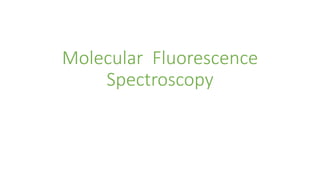
Molecular fluorescence spectroscophy
- 2. Introduction • Fluorescence and phosphorescence are particular cases of luminescence. • The mode of excitation is absorption of photon, which brings the absorbing species in to electronic excited state. • The emission of photons accompanying de excitation is then called photoluminescence • Fluorescence spectroscopy is a type of electromagnetic spectroscopy that analyses fluorescence from sample. • It involves using a beam of light, usually UV light, that excites the electrons in molecules of certain compounds and causes them to emit light. • Devices that measures fluorescence are called fluorometers.
- 3. • Fluorescence Spectroscopy is an important technique used in a wide range of applications including Food science, Water quality, Pharmaceuticals, Nanotechnology and Biochemistry.
- 4. Theory • Molecules have various excited states referred to as energy levels. • In fluorescence, absorption of UV radiation by a molecule excites it from a vibrational energy level in a electronic ground state to one of the many vibrational levels in the electronic excited state. • Collision with other molecules cause the excited molecules to lose vibrational energy until it reaches the lowest vibrational state of the excited electronic state. • The molecules drops down to one of the various vibrational levels of the ground electronic state again, emitting photon in the process. • As the molecule may drop down into any of the several vibrational levels in the ground state, the emitted photos have different energies, thus different frequencies
- 5. • By analyzing the different frequencies of light emitted in fluorescent spectroscopy, along with their relative intensities, the structure of the different vibrational levels can be determined.
- 6. Instrumentation • Spectrofluorometer Instrument has xenon lamp as a light source of exciting light. • Xenon lamps are generally useful because of their high intensity at all wavelengths ranging upward from 250 nm. • The instrument shown is equipped with monochromators to select both the excitation and emission wavelengths. • These monochromators use concave gratings, to reduce stray light. • Both monochromators are motorized to allow automatic scanning of wavelength. • The fluorescence is detected with photomultiplier and quantified with appropriate electronic devices. • The output is usually presented in graphical form and stored digitally. The Below fig also shows the components of the optical module that surrounds the sample holder. • Versatile and optical components are indispensable for a research spectrometer.
- 8. • The optical module shown in fig contains a number of convenient features that are research instrument. • Shutters are provided to eliminate the exciting light or to close off the emission channel. Beam splitter is provided in the excitation light path. This splitter reflects part of excitation light to a reference cell, which generally contains a stable reference fluorophore. • The beam splitter consist of a thin piece of clear quartz, which reflects about 4% of the incident light. • Polarizers are present in both the excitation and emission light paths. Generally polarizers are removable so that they can be inserted only for measurement fluorescent spectroscopy. • The optical module has additional has additional optical path on the right side of the sample holder. • That path allows the measurement of fluorescence anisotropy.
- 9. Monochromators • Monochromators are used to disperse polychromatic or white light into the various colors or wavelengths. This dispersion can be accomplished using prisms or diffraction gratings. • The slit widths are generally variable, and a typical monochromator will have both an entrance and exit slit. The light intensity that passes through a monochromator is approximately proportional to the square of the slit width. Larger slit widths yield increased signal levels, and therefore higher signal-to-noise ratios. • Monochromators can have planar or concave gratings . Planar gratings are usually produced mechanically. Concave gratings are usually produced by holographic and photoresist methods. • Monochromators based on concave gratings can have fewer reflecting surfaces, lower stray light, and can be more efficient. A concave grating can serve as both the diffraction and focusing element, resulting on one instead of three reflecting surfaces.
- 11. Photomultiplier tube(PMT) • Almost all fluorometers use photomultiplier tubes (PMTs) as detectors. A PMT is best regarded as a current source. • The current is proportional to the light intensity. A PMT responds to individual photons, and the pulses can be detected as an average signal or counted as individual photons.
- 12. Photomultiplier tube(PMT) • A PMT vacuum tube consists of a photocathode and a series of dynodes which are the amplification stages • The photocathode is a thin film of metal on the inside of the window. Incident photons cause electrons to be ejected from this surface. The generation efficiency of photoelectrons is dependent upon the incident wavelength. The photocathode is held at a high negative potential, typically –1000 to –2000 volts. • The dynodes are also held at negative potentials, but these potentials decrease toward zero along the dynode chain. The potential difference between the photocathode and the first dynode potential is generally fixed at a constant voltage by a Zener diode, at values ranging from –50 to –200 volts. • This potential difference causes an ejected photoelectron to be accelerated toward the first dynode. Upon collision with the first dynode the photoelectron causes 5 to 20 additional electrons to be ejected, depending on the voltage difference to this dynode. • This process continues down the dynode chain until a current pulse arrives at the anode. The size of this pulse depends upon the overall voltage applied to the PMT.
Editor's Notes
- x